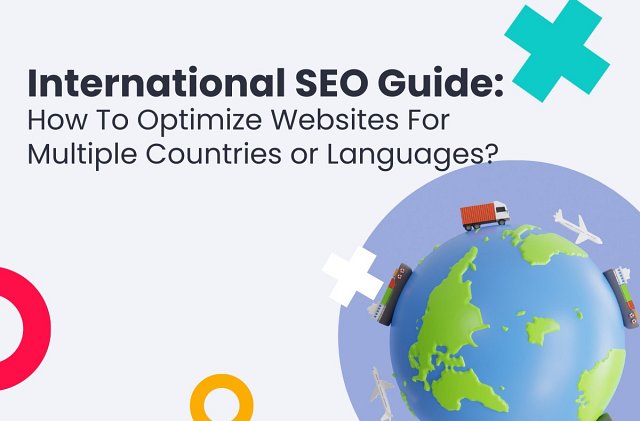(15 min. read)

What is an international SEO strategy?
An international SEO strategy is a comprehensive approach to Search Engine Optimization, helping search engines easily identify which countries you are targeting and which languages you use for business. This strategy goes beyond basic SEO practices, and includes many international features like geo-targeting or hreflang tags.
International SEO can help businesses reach foreign audiences and tailor their content and user experience to specific regions and languages, improving engagement and potentially boosting conversion rates. The world is getting more and more digital with each passing year, and with global markets on the rise, international SEO is becoming essential for many industries to rank higher in search engines results pages.
What is the difference between multilingual pages and geolocation in International SEO?
Multilingual pages refer to creating your website content in multiple language versions to cater to international users. This involves translation and localization of your content, considering language nuances and cultural context, as well as local search engine behavior.
Geolocation, on the other hand, is a practice of serving different content or redirecting users to local versions of your website based on their geographical location. This can be identified through their IP address or GPS data, or any other location-determining methods. Geolocation allows brands to tailor their content, currency, and user experience in general to each visitor’s local context.
How does international SEO work?
Unlike standard SEO, which focuses on optimizing for a singular market or language, an international SEO strategy requires a multi-faceted approach, often involving:
- Understanding local search behaviors
- Creating country-specific or language-specific content
- Implementing international technical SEO elements
- Building local relevance through backlinks
- Adjusting to local User Experience standards
Both on-page and off-site aspects of SEO can be optimized internationally. For on-page optimizations, webmasters can adjust their sites’ URL structure, optimize hreflang tags, localize their content, and translate meta tags and other SEO elements for local languages and keywords. Some international off-site strategies include localized link building and engagement on social platforms popular in the target region.
International SEO fundamentals
Optimizing your website for a global audience requires a solid foundation. The fundamentals of international SEO are:
- Market Analysis
- Keyword Research
- Competitor Analysis
- Domain Structure Strategy
- Keyword Research
- Localization
- Link Building
Market Analysis
Before diving into any SEO work, you have to understand the markets you’re entering. Market analysis helps you evaluate the economic and cultural landscapes in a given region, and involves looking at the market size and its potential, cultural nuances, as well as any legal and regulatory requirements that may impact your online presence.
Keyword Research
Keywords are always at the core of SEO. International keyword research involves more than translating existing keywords - it’s about understanding what your global audience is searching for in their respective languages. This includes analyzing which terms are most commonly searched for in each target market, getting to the root of user intent, and identifying which keywords local competitors are ranking for.
Competitor Analysis
Knowing who you’re up against in each market can shape your international SEO strategy. A thorough competitor analysis should look at your competitors’ market share (who dominates the market and why), their SEO strategies (what tactics they are using, and how you can differentiate your approach), as well as their link building practices (which types of content and backlinks are driving traffic for them).
Domain Structure Strategy
The structure of your domain can greatly affect your international SEO score. Investing in ccTLDs, or Country Code Top-Level Domains, can help signal to search engines and users that your content is designed for their country in particular. You can also use language- or country-specific subdomains and subdirectories, or use gTLDs (generic top-level domains) with language parameters in the URL structure.
Localization
Localization ensures your content resonates with the local audience. It’s not just about translating it, but also about the cultural customization (adapting visuals, references, and content formats to suit local tastes). Technical localization is also important, and includes using local currencies, measurement systems, and date formats. Make sure your content complies with local regulations as well.
Link Building
Links from local websites can significantly boost your SEO performance in a specific region by establishing local relevance. High-quality, local backlinks can increase your site’s trustworthiness, contributing to your international SEO profile. Ideally, you want diverse backlinks from different regions to enhance international authority.
How to implement international SEO?
Implementing an international SEO strategy requires just as much care and preparation as your local SEO efforts. You’ll need careful planning and strategic decision-making, with an approach tailored to the specific international markets you’re targeting. Follow these critical steps to create a robust international SEO strategy:
Choose the right international domain structure
The structure of your website’s domain will play a vital role in your international online visibility, as it can significantly impact how search engines and users see your site’s relevance to their region.
ccTLD
Using Country Code Top-Level Domains (ccTLDs) allows search engines to immediately recognize the geographic focus of your website, and users often trust domains that correspond with their country, potentially increasing click-through rates. On the other hand, each ccTLD requires individual management, which can be resource-intensive, and link equity won’t be shared across ccTLDs, meaning each domain will have to build authority from scratch.
Example: domain.de
Subdomain
Using subdomains is a flexible choice, as you can set up different SEO strategies for each. They are consolidated with your main hosting and can reside on a single server, simplifying the process. When it comes to their downsides, they can sometimes be seen as separate from the main brand, potentially diluting your branding, and similarly to ccTLDs, subdomains may not benefit from the full authority of the primary domain.
Example: de.domain.com
Subdirectory
Finally, using subdirectories gives you all the benefits from the main domain’s established SEO efforts and authority. It’s also much easier to manage content and track analytics from a single domain structure. Unfortunately, it may be harder for search engines to recognize the intended geography, though this can be mitigated somewhat with other SEO signals. Also, any site-wide penalties or issues will affect all regional subdirectories as well.
Example: domain.com/
Implement hreflang tags
Hreflang tags are essential in signaling to search engines what language and region your content is targeting. When properly implemented, they can help make sure that the correct version of your site is shown to users in search results.
These tags are snippets of code that tell search engines about the language and geographic targeting of a webpage. They are extremely useful when you have multiple versions of a webpage in different languages.
Here's how a hreflang tag may look like in HTML:
<link rel="alternate" hreflang="de" href="http://
- link rel=”alternate” - This part tags the link as an alternate version of this page.
- hreflang=”de” - This part establishes that the alternate site is a different language version, in this case “de” is the alpha-2 code for German.
- href="http://
example.com/ de" - This part provides the URL for the alternate page.
Create content strategy for international SEO
Creating a content strategy that resonates across different international markets is more nuanced than a simple translation of your existing content. Here are the three main steps:
Keyword research for international markets
A localized keyword analysis within each target market is necessary to account for cultural nuances and local search behavior. It’ll also help you understand what the local audiences intend to find with their searches, as intent can vary by region and culture.
Optimizing content for international SEO
Adapt your content to reflect local traditions, values, and humor - all the while remaining true to your overall brand communication. Make sure all the technical elements like currency and units of measure follow local conventions, and see to it that the content you create is relevant within specific regions.
Your URLs, meta titles, and meta descriptions should always be optimized as well. They can contribute heavily to your SERP rankings. Finally, make sure all your internal links lead to appropriate local versions.
Handling duplicate content and canonicalization issues
Canonical tags are essential in international SEO for managing similar content across different languages and regional versions of a website.
Fundamentally, a canonical URL is the URL that you want search engines to index. However, when your site has several pages in different language versions, it can be challenging for search engines to identify the correct canonical URLs for indexing. This is particularly important when the content is similar but slightly modified for local nuances.
The most effective solution is to explicitly indicate the preferred URLs to the search engines using the 'rel=canonical' tag. This tag should be integrated into all pages, regardless of the language version you wish to index.
Create unique content for each region to avoid cannibalization - use canonical tags to point to the preferred version of a page if duplicate content is unavoidable.
Localize your website
Localization is a comprehensive process of adapting your website to meet the linguistic and cultural expectations of each target market. When executed correctly, localization can be a powerful tool for SEO, making your site more relevant, accessible, and engaging for local audiences.
Translation and cultural adaptation
The first step in localization is translating your website content - but effective localization requires more than word-for-word translation; it involves cultural adaptation. This means that idioms, humor, cultural references, and other unique aspects of foreign cultures should be adjusted to align with the local population. Employ skilled translators who are native speakers and understand the local dialects and regional nuances. Avoid cultural taboos that could alienate your international audience.
Adapting keywords to local vernacular
International keywords must reflect the local slang and jargon that your target audience uses to search for products or services similar to yours. Use metaphors and expressions that carry the correct connotations within the local context around your keywords as well.
Considering local currencies, images, and colors
Implement an accurate and dynamic currency conversion system to cater to local markets better. Visual elements can have different connotations in different cultures as well, and should be chosen with care. Use images that depict local people, landmarks, and scenarios to create a connection with your target audience. Understand the symbolism of colors in different cultures also to make sure they convey the desired messages and emotions.
Link building strategies for international SEO
A successful international SEO strategy requires more than just on-site optimizations - it requires a strong off-site presence as well. Link building is a crucial component of all SEO efforts, as it signals to search engines that other websites consider your content valuable enough to link to.
In your international SEO efforts, it's not just the number and quality of backlinks that matter, but also their geographical relevance. It's imperative that your backlinks come from the specific countries you are targeting. This relevance tells search engines that your content is important within that particular local market. Promote your content to local bloggers, businesses, and media outlets, and engage with forums and online communities popular within each target country to promote local backlinks.
WhitePress as a platform for international outreach
Content marketing platforms like WhitePress can be instrumental in managing and facilitating international link-building campaigns. They provide access to a global database of publishers and websites from around the world and help in localized campaign management of link-building efforts in different languages through one interface.
Boost Your SEO with Local Backlinks
- Link building in the USA
- Link building in the UK
- Link building in Romania
- Link building in Germany
- Link building in France
- Link building in Italy
- Link building in Spain
- Link building in the Netherlands
- Link building in Poland
- Link building in Denmark
- Link building in Sweden
International SEO best practices
Building an international SEO strategy isn’t easy. To make sure the results will bring you success, it may be wise to follow common international SEO best practices. These tips are sure ways to enhance your visibility across different regions and cater to the local experience in various countries - consider including them in your strategy for optimal effects.
Google Business Profile
For businesses with physical locations in multiple countries, a well-optimized Google Business Profile (formerly known as Google My Business) for each is critical.
Make sure that each country’s and each location’s business profile is accurate and localized. Your profiles should show the correct name, address, phone number, and website URL, with all information in local languages. Actively manage reviews on each profile, and make sure you respond to customers’ feedback in their language.
Use social media to amplify your content
Social media platforms are a powerful tool for international reach - research and use the networks available and popular in each target country. Make sure the content you create appeals to each market individually, including your posts, visual content, and even hashtags. Engage with local users, influencers, and other brands to increase your visibility and build a community around your brand in each market.
Localize your paid search campaigns
Paid search campaigns can quickly increase your visibility in new markets, and localizing them can improve their effectiveness further. Use localized keywords that reflect the local search behavior, and allocate your PPC budget based on the market potential and competition in each country to keep your spending proportional to the expected ROI.
International SEO tracking
Optimizing your international SEO strategy requires continuous monitoring and tracking key performance metrics. With the right tracking tools, you can better understand how well your website is performing in different markets and receive actionable insights into where improvements can be made.
When monitoring your international SEO efforts, consider these indicators:
- Organic Traffic by Region
- Keywords Rankings by Language/
Country - Click-through Rates (CTRs)
- Bounce Rate
- User Engagement (Time on Page, Pages per Session, etc.)
- Backlink Origin and Local Link Authority
- User Flow on Alternative Pages
Useful tools for international SEO
As you can see, there’s a lot that goes into your international SEO rankings - thankfully, there are sophisticated tools that can help you by offering deep insights and automating mundane tasks. You can analyze real-time data from different regions of the world, designed to help you better understand international markets and optimize your strategy.
Several all-in-one SEO platforms are equipped with features created specifically for managing international SEO campaigns. This includes SEMrush with its robust keyword tracking and market research across different countries and languages; Ahrefs with a detailed backlink analysis tools to monitor your international link building (and identify opportunities); or Moz with tools that help track local and global rankings, prepare site-wide audits, and manage content marketing efforts.
With Google Trends, you can easily research search behavior of users around the world, comparing popularity of search queries across different languages and regions. The Google Search Console, on the other hand, is an essential SEO tool that can aid you with precise data on how your website is performing globally - this includes geographic performance and even identifying issues with hreflang tags.
AI chatbots like ChatGPT or Google’s Bard can also come in handy in your international SEO strategy. You can use AI tools to generate content ideas or draft content in multiple languages that can be fine-tuned by native speakers, while customer support chatbots can help instantly resolve problems in users’ native language.
SEO international checklist
A structured approach can help you systematically optimize your international presence - follow this concise checklist to guide you through the key things to remember in your SEO strategy:
- Conduct thorough market research to better understand each target country.
- Choose the right URL structure strategy between ccTLDs, subdomains, or subdirectories for your international sites.
- Use hreflang tags to signal search engines which local language and country your content is targeting.
- Translate and localize your content for cultural relevance and accuracy.
- Conduct keyword research for each target market and prioritize local search volume and competition.
- Acquire local backlinks from reputable websites within the target region.
- Optimize title tags, meta descriptions, and content with relevant keywords.
- Audit site speed across alternative sites and check for crawl errors in Google Search Console.
- Monitor organic traffic, rankings, and conversions by region.
- Use social media platforms favored in your target markets.
- Keep track of international SEO performance and iterate your strategy.
- Implement SEO tools that provide insights and automate tasks.
- Work with local SEO experts to understand the nuances of the region.
Challenges for international SEO
Optimizing multiple international websites is an ambitious strategy that comes with a unique set of challenges. International SEO is a complex undertaking with obstacles that range from technical implementation to content creation and legal compliance. Each country has its own set of digital laws and regulations, which can include restrictions on content or data privacy requirements (like the GDPR in the EU).
Creating unique content for each market while maintaining brand consistency is yet another challenge. Tailoring content to reflect local customs and culture is complex and requires insight, beyond simple translation. On top of that, add managing multiple websites and domains, trying to avoid duplicate content and making sure users get a consistent experience across all sites.
Given the complexities involved, many businesses decide to work with an SEO agency that specializes in international SEO. These agencies have the experience and knowledge required to navigate the challenges of international markets, and work with established processes and tools to achieve more in less time. They may also have connections with media and influencers across different countries, which can aid in link-building and PR. Working with a reliable agency can help you extend beyond borders and effectively promote your brand in foreign markets.
FAQ
What is the difference between local and international SEO?
Local SEO and international SEO both aim to optimize your website’s visibility and search results, but they target different audiences and may involve different strategies.
Local SEO targets users in a specific city or location, and is used in particular by businesses that serve customers locally, like restaurants, stores, or service providers. On the other hand, international SEO targets users in multiple countries and/
How can I tell if my website is optimized for international SEO?
To determine if your website is well-optimized, a thorough review of your website and its performance across different regions is needed. Track your analytics to see if you’re attracting visitors from your target international markets, and use SEO tools to check if your website ranks for the intended keywords. Analyze bounce rates, average session durations, and pages per session for international visitors to evaluate engagement and adjust strategy.



